
 |
Windows 11 FAQ |
Updated: 05 July 2025
1. How do I change my network setting in Windows 11?
Windows 10 has introduced the Network and Sharing Center where you can view and manage your network settings from one location. To access it, click on the Start menu, select Control Panel, and under Network and Internet select View network status and tasks. Also it is accessible from the Network icon on the start menu.
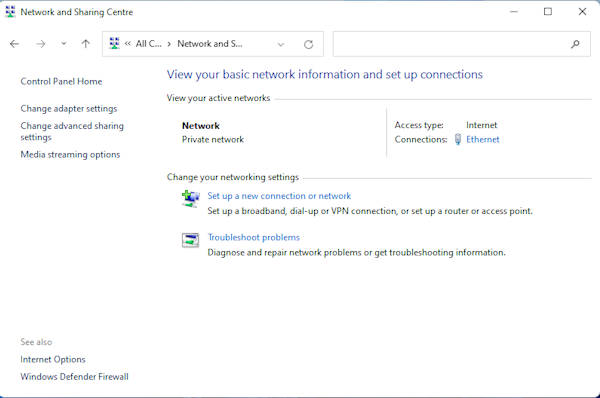
To change individual network connections such as the Ethernet Local Area Connection, click on Change adapter settings.
2. What do the Sharing and Discovery options do?
a) Network discovery. Enable this option to allow Windows to see
other computers on the network and allow other computers to see the Windows 10 computer.
Click on View computers and devices to display other computers on the
network.
b) File and printer sharing. Enable this option to allow folders and files and printers to be
shared with other computers on the network.
c) Public folder sharing. This allows sharing of the Public folder (i.e.
C:\Users\Public) with other computers. You can specify whether its read only
access or allow users to create or modify files in the Public folder.
d) Printer sharing. This option allows other users to access shared printers
on your computer with other computers.
e) Password protected sharing. This enables only authenticated users
access to shared resources on your computer. To allow guests and any other user,
disable this option. To add users use the User Accounts control panel.
f) Media streaming. This allows other users and media devices to access
music and video files on your computer.
3. What is Internet Protocol Version 6 (TCP/IP)?
IPv6 was introduced first with Windows XP and Windows 2003 to expand on IPv4
to get past the limitation of a maximum of 4 Billion IP addresses using the
old 32 bit system. IPv6 now uses a much longer IP address using Hexadecimal
numbers. Windows will automatically assign an IPv6 address when you configure
your normal IPv4 address. Here is an example of an IPv6 address:
fe80::4490:9230:7194:a69b. You can view the IPv6 address by clicking on Details on the network connection properties or use the IPConfig
tool.
4. How do I enable or configure Windows Firewall?
The Firewall in Windows can block outgoing and incoming traffic to your computer. To configue it, goto Start, Control Panel, Network and Internet, Windows Firewall. You can add or remove programs allowed through the Firewall by selecting Allow an app or feature through Windows Firewall:
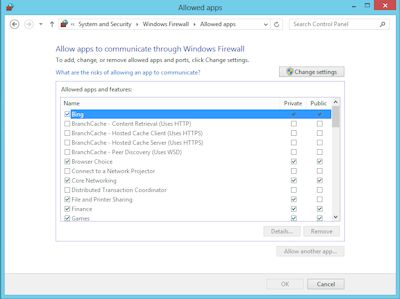
Click on Change settings and then Add another app and select the program from the list or Browse for the program on the hard disk. If you have uninstalled a program, use the Remove button to remove the program from the Exception list. If you want to allow specific protocols or ports then use the Advanced Settings instead, this will load the Windows Firewall with Advanced Security window.
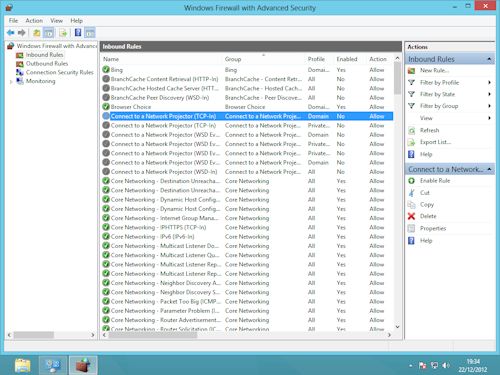
5. How do I change the Computer or Workgroup name?
Windows 11 can use Workgroups or Domains (in Professional, Business, Enterprise or Ultimate editions).
In Windows 11, you can change the computer name in Settings, System, About, Advanced system settings, Computer Name, then Change.
Alternatively, you can change the computer or workgroup name in the Control Panel, System Maintenance, System and click on Advanced system settings. Then select Computer Name tab and select Change.
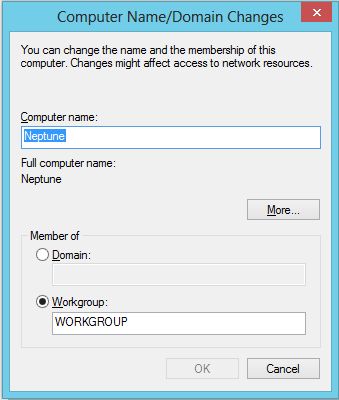
6. How do I share a folder for other computers to access them?
To share a folder, select the folder, right click it and a pop up menu will appear. Select Share from the menu and the following window will appear.
To set up sharing use the Advanced Sharing to enable sharing and set
the share name and which users can have permission to access files in the share.
You can enable the Sharing Wizard in Windows to make sharing files
and folders easier. See Organize, Folder and Search Options, View menu.
In File Sharing, you can add users (or groups) to share files with as follows:
a) Right click the folder to share, and select Share with..., Specific people
b) Enter the name of user to share with or select user from a list (use Guest to share with anyone), and click on Add
c) By default, the permission level is set to Reader (user can only read files).
d) Change the permission to Read/Write if necesssary.
e) Click Share, the name of the Share is set automatically to the name of the folder.
f) Click Done.
To remove the share:
a) Right click the folder that is shared, select Share with...
b) Select Stop Sharing.
7. I cannot get Windows 11 to work with shares with other computers such as Windows 2000, XP or 2003?
Windows 10 and 11 uses NTLMv2 only by default. You can change it so it can use
NTLM or NTLMv2 by changing the Local Security policy.
Open the Local Security Policy console in Administrative Tools,
expand Local Policies, Security Options and look for Network Security:
LAN Manager authentication level. Change the option from Send NTLMv2 response
only to Send LM & NTLM - use NTLMv2 session
security if negotiated.
If you have the standard edition, then load Regedit and browse to HKLM\System\CurrentControlSet\Control\Lsa
and
change the LmCompatibilityLevel to 1.
Also, you can enable SMBv1 via Programs and features, Turn Windows Features on or off, and enable SMB 1.0/CIFS File Sharing Support.
8. How do I setup a Web Server on Windows 11?
In Windows, you can enable the IIS web server feature, as follows:
i) Open the Control Panel, select Programs and Features.
ii) Select
Turn Windows features on or off.
iii) Expand Internet Information Services
iv) Enable World Wide Web Servies and Web Management Tools.
v) Click OK to install the new features.
vi) Once installed, you can create your new web pages in C:\Inetpub\wwwroot folder.
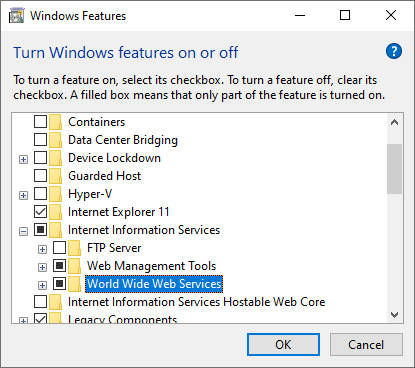
9. Can I connect my computer to the internet via my Smart Phone?
Yes, you can do this if your computer has a WiFi network adapter installed (or a USB version) and enabled the following on your Android phone.
i) In Network settings, enable Use packet data and Use only 2G Networks.
ii) In Network, Tethering and portable hotspors, enable Mobile AP
iii) On the PC, enable the wireless network and select the Android AP option to connect to the internet.
10. What do the different network protocols, services and clients do?
A typical network adapter may have several protocols, clients and services attached and they do different jobs over the network.
a) Client for Microsoft Networks. This is required for sharing resources between PCs or Servers in a workgroup or domain.
b) File and Print Sharing for Microsoft Networks. Required for access file shares and shared printers between PCs and servers.
c) QoS Packet Scheduler. Ensures Quality of Services for certain data packets over network esp. video and audio traffic.
d) Internet Protocol Version 4 (TCP/IPv4). This enables access to services over the internet using Transport Control Protocol/Internet Protocol using 32-bit number system e.g. 10.0.0.1
e)
Link-Layer Topology Discovery Mapper (LLDP). Discovers other devices connect to the network such as other PCs, routers, NAS drives etc (see Network icon in Explorer).
f)
Microsoft Network Adapter Multiplexor Protocol. Use for NIC teaming and binding for load balancing network traffic with two or more network adapters.
g)
Microsoft LLDP Protocol Driver. Uses the Link-Layer Discovery Protocol for discovery other devices on the network.
h) Internet Protocol Version 6 (TCP/IPv6).
This enables access to services over the internet using Transport Control Protocol/Internet Protocol using 128-bit number system.
i)
Link-Layer Topology Discovery Responder. Responds to other devices searching for devices on the network.
j) Link-Layer Topology Discovery Mapper I/O Driver. Used to discover and locate other PCs and devices on the network.
11. How do I connect to a Virtual Private Network (VPN)?
A Virtual Private Network (VPN) is an additional network on top of your normal local network which has a secure connection to your work place's network via their firewall or VPN server.
This basically means that when you connect to the VPN network, your computer is now part of your work place's network and allow access to services and resources inside that network that are
not normally accessible over normal internet connections. Since the connection is secure, any network traffic is automatically encrypted, so data is not readable by third parties.
To connect to a VPN you need a VPN client. You should always use the client software that your work place recommends and/or provides for you.
In Windows, you can use the Network and Sharing Control Panel to set up a VPN connection to your work place. Open Control Panel, select Network and Sharing Centre,
select 'Setup a new connection or network' , then 'Connect to a workplace'.
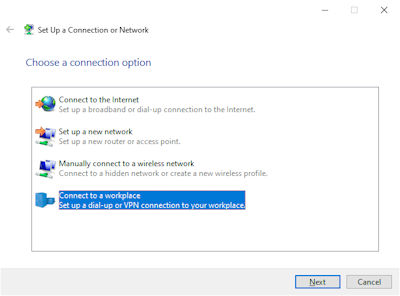
Select type of connection: via internet or via a phone number, and if internet, enter a internet address of VPN service or a telephone number (you need a dial up modem for this).
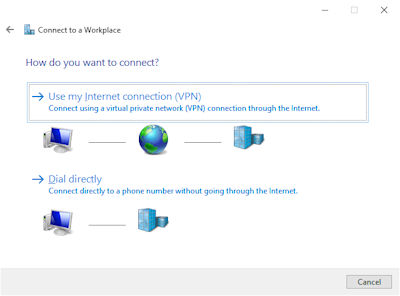
12. How do I communicate to someone over the internet?
There are many clients available that allow you to talk and view another person over the internet using a Webcam and a headset with ear phones and a microphone.
a) Classic Skype client (see Microsoft Store)
b) Client such as Skype for Business for workplace communication.
c) Microsoft Teams for Office 365 users.
d) Zoom client.
e) GotoMeeting client.
13. How do I access services via a standard desktop interface?
Remote desktop services allow you to provide a standard desktop or a suite of applications that can be access remotely via the web interface or a client.
Microsoft's remote desktop services provides either Session-based virtualization using Windows server or Virtual Desktop Infrastructure (VDI) to ensure high
performance and maximum application compatibility for running important applications. Usually RDS is accessible via a web interface e.g. https://rds-address/rdweb
or a client.
Alternatives or in addition to RDS, you can use other solutions such as Parallels Remote Application Server (RAS), or Citrix Virtual Apps and Desktops, and
Amazon Workspaces, Remote Desktop and the Windows App.
To login to other Windows compuer you will need to use the Microsoft Remote Desktop Connection software. You can then connect to any Windows desktop
or server on your local network or over a VPN connection.